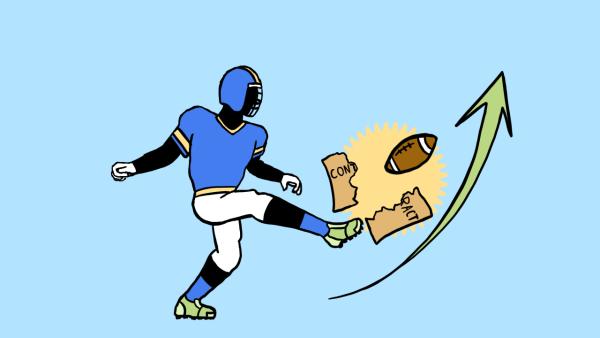[Opinion] Football harms teenagers’ physical and mental health
Football is a dangerous sport and can cause many injuries.
October 12, 2022
Schools across the U.S. offer a wide variety of sports, but the most popular one is football. This well-known sport offers a range of positive impacts, such as creating numerous opportunities for future careers. However, the sport also makes teenager’s bodies more vulnerable to serious injuries that could harm their day-to-day life. In many cases, these injuries are not seriously acknowledged until an influential football star gets hurt.
On Sept. 29, an NFL game between the Miami Dolphins and the Cincinnati Bengals led up to Miami Dolphins quarterback getting seriously hurt during the game. The Dolphins’ quarterback, Tua Tagovailoa, had been struck in the head and neck by Cincinnati Bengals defensive lineman Josh Tupou. The opposing team player’s force gave Tagovailoa a brutal fall which questioned the safety of many football players. His fall looked serious, but organizations claim his injuries consisted simply of a concussion. However, after this injury he was later escorted and hospitalized for possible neurological trauma.
Four days before his second injury, Tagivailoa was able to return to a game after Buffalo Bills linebacker Matt Milano struck him in the head during a pass. According to ESPN, the NFL players association requested a review of the concussion protocol because Tagivailoa returned to a game after just a quick evaluation during half-time. This indicates that his fall was not taken as seriously since they performed quickly so Tagovailoa could return to the game. The NFL organization is now facing a potential lawsuit from the NFL Players Association due to the many concerns of the health of players.
This story gives an insight on how dangerous it is for high schoolers to be playing football. High school football players are young and still developing which means they are more susceptible to brain damage due to their forming brains. Along with these brain injuries, these young adults may also give in to the pressure of joining a team sport that involves harsh contact with other people.
Serious injuries are likely to occur due to aggressive tackling and brute force of team players who believe no damage will be done with a helmet on. In reality, there are not only head injuries involved with the sport, but also ankle sprains, hamstring injuries and meniscus tears occur as well. The requirement that football players must have safety pads gives them a false sense of protection and lures more young adults to try out for their high school team.
According to statistics gathered over the years, NFL’s injury data shows an alarmingly increasing amount of accidents during football. These incidents range from a total of 172 concussions in 2020, to 187 concussions in 2021 during the preseason and regular season.
Not only are there physical harms, but football can also affect one’s mental health. The sport comes with a toxic mindset that to succeed in life they must succeed on the football field. This can lead to a decrease in self-esteem and create a loss of identity after experiencing failure amongst peers.
Pressure levels in these youth groups can also increase from coaches that teach them to put themselves in danger to become successful. In serious cases, coaches create a different way of “motivation” towards their players which can result in bullying or verbal abuse.
After interviewing NFL players’ mental health, The Harvard Football Players Health Study shows that several players are afraid of seeking help for their mental health in fear that it could negatively impact their careers. The stress and anxiety when stepping onto the field are often ignored by organizations, making a dangerous environment for youth groups more susceptible to these dangers.
High school students are continuing to grow and develop and football could disrupt that process. Football is a large time commitment that rarely rewards students with scholarships, despite the risk of harm to those students. According to Signature College Counseling, only about 2% of students are offered athletic scholarships.
Harming students physically and mentally, football is not an adequate sport for those who are easily influenced and would be willing to put themselves in danger to be a “part of the team”. High school football is time consuming and potentially harmful to those who decide to be a part of the program. Schools should not enable students to play these potentially life-threatening sports. Even if it is a minor injury, football does not guarantee a speedy recovery for all teenagers.
























